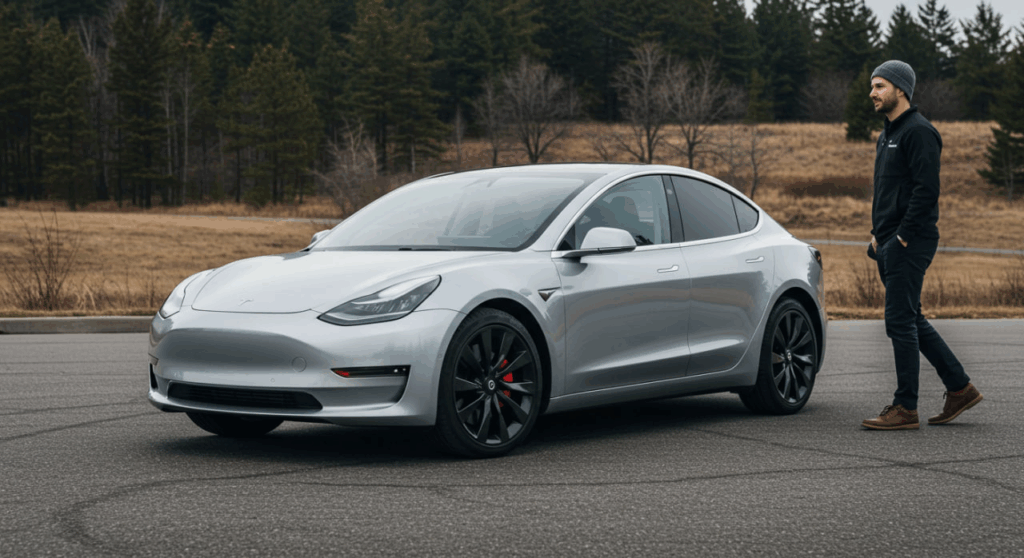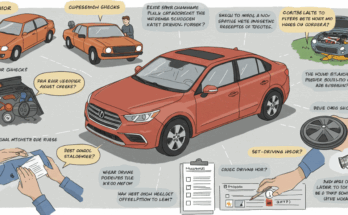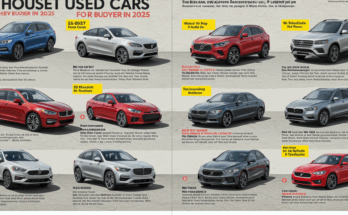Hey there! So, you’re thinking about joining the Tesla family—great choice! Tesla’s Model 3 and Model Y are two of the most popular electric vehicles out there, and it’s no surprise why. They’re packed with cutting-edge tech, zippy performance, and that signature Tesla style. But choosing between the sleek Model 3 sedan and the roomier Model Y SUV can be tricky. Don’t worry—I’ve got you covered with a detailed breakdown to help you decide which one’s right for you. Let’s dive in!
Introduction: Why Tesla?
Tesla has redefined what it means to drive electric. The Model 3 and Model Y are the brand’s most accessible models, making EVs practical for everyday folks while still delivering luxury and performance. In 2023 alone, the Model Y sold over 1.2 million units globally, making it the world’s best-selling car in some markets (Top Gear). The Model 3 isn’t far behind, with its sporty vibe and impressive range. Both cars share a lot of DNA, but their differences in design, space, and purpose can make one a better fit depending on your needs. So, let’s compare them across the key factors that matter most to buyers.

Price and Value
Let’s start with the wallet. As of 2025, the Model 3 kicks off at around $42,490 for the Long Range Rear-Wheel Drive (RWD) version, while the Model Y starts at $44,990 for its Long Range RWD trim (U.S. News). Here’s a quick look at the pricing for their main trims:
| Model | Trim | Starting Price |
|---|---|---|
| Model 3 | Long Range RWD | $42,490 |
| Model 3 | Long Range AWD | $47,490 |
| Model 3 | Performance | $54,990 |
| Model Y | Long Range RWD | $44,990 |
| Model Y | Long Range AWD | $47,990 |
| Model Y | Performance | $51,490 |
The Model 3 is generally the more affordable option, but the gap isn’t huge—sometimes as little as $1,000-$3,000 depending on the trim. Interestingly, the Model Y Performance is cheaper than the Model 3 Performance, which might appeal to speed enthusiasts on a budget. However, Tesla’s pricing can be a moving target, and federal tax credits or local incentives can shift the equation. For instance, some Model Y configurations may qualify for a $7,500 federal tax credit in the U.S., while many Model 3 trims don’t (InsideEVs). Always double-check Tesla’s pricing page for the latest details.
Why It Matters: If you’re pinching pennies, the Model 3’s lower starting price could save you a few grand. But if you’re eyeing performance or qualify for tax credits, the Model Y might offer better value.
Design and Dimensions
The Model 3 and Model Y look like siblings, but their body styles set them apart. The Model 3 is a sedan with a sleek, low-slung profile that screams sporty elegance. The Model Y, on the other hand, is a compact SUV with a taller stance and a hatchback design, giving it a more practical, family-friendly vibe. Here’s how their dimensions compare (Car and Driver):
| Aspect | Model 3 | Model Y |
|---|---|---|
| Length | 184.8 inches | 187.0 inches |
| Width | 72.8 inches | 75.6 inches |
| Height | 56.8 inches | 63.9 inches |
| Wheelbase | 113.2 inches | 113.8 inches |
| Ground Clearance | Lower by 1.1 inches | Higher by 1.1 inches |
The Model Y’s extra height and width make it feel roomier inside, especially in the rear seats. It offers 39.4 inches of rear headroom and 40.5 inches of rear legroom, compared to the Model 3’s 37.7 inches and 35.2 inches (MotorTrend). This makes the Model Y more comfortable for taller passengers or those with car seats.
Cargo space is where the Model Y really shines. It boasts 76 cubic feet of total cargo space with the rear seats folded, compared to the Model 3’s 24 cubic feet (U.S. News). The Model Y’s hatchback design also makes loading bulky items easier, and it has a deeper front trunk (frunk). Plus, you can add a third row of seats for $2,000, bringing the total to seven passengers—though that third row is best for kids. The Model 3’s trunk is still decent at 15 cubic feet, but it’s less versatile for large loads.
Why It Matters: If you need space for gear, kids, or pets, the Model Y’s SUV design and massive cargo capacity are hard to beat. If you’re a solo driver or don’t haul much, the Model 3’s sleek sedan style might be more your speed.
Performance and Range
Both cars are ridiculously quick, but the Model 3 has a slight edge for performance junkies. Here’s a breakdown of their specs (Tom’s Guide):
| Aspect | Model 3 | Model Y |
|---|---|---|
| 0-60 mph | RWD: 4.9s, AWD: 4.2s, Performance: 2.9s | RWD: 6.5s, AWD: 4.8s, Performance: 3.5s |
| Top Speed | RWD/AWD: 125 mph, Performance: 163 mph | RWD/AWD: 135 mph, Performance: 155 mph |
| Horsepower | RWD: 257 hp, AWD: 393 hp, Perf: 510 hp | RWD/AWD: 390 hp, Performance: 418 hp |
| Range (EPA) | RWD: 363 mi, AWD: 341 mi, Perf: 303 mi | RWD: 337 mi, AWD: 308 mi, Perf: 277 mi |
The Model 3 Performance is a beast, hitting 0-60 mph in just 2.9 seconds, making it one of the fastest EVs in its price range. The Model Y Performance is no slouch at 3.5 seconds, but the Model 3’s lighter weight (about 344 pounds less) gives it a sportier feel (MotorTrend). The Model 3 also has a unique Track Mode, which isn’t available on the Model Y, perfect for those who want to push their car to the limit.
For range, the Model 3 Long Range RWD leads with 363 miles, compared to the Model Y Long Range RWD’s 337 miles. Both are excellent for long trips, and Tesla’s Supercharger network makes charging a breeze, adding about 150-200 miles in 15 minutes (U.S. News). Home charging with a Level 2 charger takes about 10-12 hours for a full charge on either model.
Why It Matters: If you crave speed and a sporty drive, the Model 3 is your pick. For range, it also has a slight edge, but both are great for daily commutes and road trips.
Technology and Features
Tesla is synonymous with tech, and both models deliver. They share a 15-inch touchscreen that controls nearly everything, from navigation to climate settings. Both come with Autopilot, which includes adaptive cruise control, lane-keeping assist, and collision warnings. You can upgrade to the Full Self-Driving package for $8,000, though it’s not true Level 5 autonomy (Tom’s Guide). Other shared features include:
- Sentry Mode: Uses cameras to monitor your car when parked.
- Mobile App Control: Lock, unlock, or preheat your car from your phone.
- Over-the-Air Updates: Regular software updates add new features.
- Wireless Charging: Standard on both models.
The Model Y has a slight edge in practicality, with a one-piece glass roof for a panoramic view and a Camp Mode that’s great for sleeping or camping (MotorTrend). Its higher seating position also makes the touchscreen easier to use for some drivers. The Model 3, however, feels more refined after its 2024 “Highland” refresh, with a quieter cabin and better suspension (InsideEVs).
Why It Matters: Tech-wise, they’re nearly identical, but the Model Y’s extra space and features like Camp Mode add versatility for adventurers.
User Experiences and Reviews
What do actual owners think? I scoured Reddit for real-world insights, and here’s what stood out:
- Model Y Fans: Many owners love the Model Y’s space and practicality. One user said, “I got the Y because my kids were bigger, we needed more space, and trade-in values were stupid” (Reddit). Another noted, “Y is way more comfortable to get in and out, more spacious, and the hatch is more useful” (Reddit).
- Model 3 Enthusiasts: Model 3 owners often praise its sporty handling and sleek design. One said, “The 3 is funnier to drive but Y necessary for family of 4” (Reddit). Another added, “The 3 is one of the sexiest cars I’ve ever seen” (Reddit).
- Regrets and Trade-offs: Some Model 3 owners wished they’d chosen the Model Y for more space, especially for growing families. One user said, “I’m worried that maybe if I get the 3, I will want more space later down the road” (Reddit). Conversely, some Model Y owners missed the Model 3’s nimble handling.
- Unique Perspectives: A Model 3 owner who switched to a Model Y said, “It’s so much better. Nicer ride height, way more storage, more legroom” (Reddit). Meanwhile, a performance enthusiast noted, “The Model 3 Performance is going to be really fun to drive” (Reddit).
These stories highlight a key point: your choice might depend on where you are in life and where you’re headed. If you’re young and single, the Model 3’s sporty vibe might be perfect. But if you’re planning for a family or love road trips, the Model Y’s versatility is hard to beat.
Why It Matters: Owner feedback shows the Model 3 excels for driving enthusiasts, while the Model Y is a favorite for those needing space and flexibility.
Which One Should You Buy?
So, which Tesla is right for you? Here’s a quick guide based on your needs:
- Choose the Model 3 if:
- You’re on a tighter budget (starts at $42,490).
- You want a sportier, more agile driving experience.
- You don’t need much cargo space.
- You’re single or have a small family.
- You prioritize range (up to 363 miles).
- Choose the Model Y if:
- You need more cargo space (76 cu ft) or seating for up to seven.
- You prefer the higher ride height of an SUV.
- You’re planning for future needs, like a growing family.
- You want a versatile vehicle for camping or road trips.
If I had to pick, I’d lean toward the Model Y for its practicality. That extra cargo space and optional third row make it a car that grows with you, whether you’re hauling gear for a weekend getaway or carpooling kids. But if you’re all about speed and don’t need the extra room, the Model 3 Performance is an absolute thrill ride.
Conclusion: Test Drive and Decide
At the end of the day, both the Model 3 and Model Y are fantastic EVs with Tesla’s signature tech and performance. The Model 3 is your go-to for a sporty, budget-friendly ride with great range, while the Model Y is the practical choice for families or those needing more space. The best way to decide? Get behind the wheel of both. Test drives will help you feel the difference in handling, space, and vibe. Plus, Tesla’s Supercharger network means you’ll never be far from a quick charge, no matter which you choose.
So, what’s it going to be—sedan or SUV? Either way, you’re in for an electrifying ride. Happy driving!



